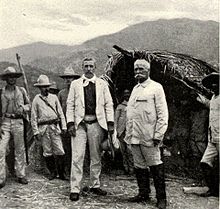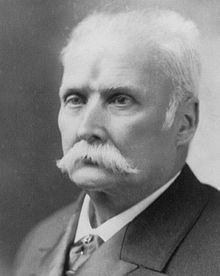Calixto García
Calixto García Íñiguez (born August 4, 1839 in Holguín , † December 11, 1898 in New York ) was a general in the three Cuban Wars of Independence .
Origin and family
García's parents, Ramón García y González and Lucía Íñiguez y Landín Moreno, were of Cuban Creole descent . His maternal surname Íñiguez indicates a relationship to Íñigo Arista , a Basque king whose forces are called demons in the song of Roland .
Calixto García has been described as a tall, strong, educated, and very irascible man. He is the grandson of Calixto García de Luna e Izquierdo , who fought in the Battle of Carabobo in what is now Venezuela . His grandfather gave up the aristocratic name “de Luna” because he fled to Cuba. He had previously been arrested on March 18, 1837 for his demands for the release of slaves and equal constitutional freedoms for all, as well as for attempting to hang an opposing priest. As was common with men of his class at the time, Calixto García had numerous mistresses in addition to his wife, Isabel Vélez Cabrera . In addition to around seven legitimate children, he had at least six illegitimate children, each from different women. Some of his sons, including the most important Carlos García Vélez and Calixto Enamorado , fought in his armies.
Theaters of war
At the age of 18, Calixto García followed his grandfather and joined the Cuban insurgents , which shortly afterwards resulted in the first war for Cuba's independence from Spanish colonial rule , the Ten Years' War . García fought against the Spaniards until he was captured after a good five years. Not wanting to allow the Spaniards the triumph of his capture, he shot himself in the chin with a .45 pistol. Although the bullet came out again through the forehead .
García was captured by Lieutenant Francisco Ariza Gomez and then transported to Veguitas, where Spanish military doctors saved his life. García survived but suffered a headache for the rest of his life and a large scar remained. When Spanish officials came to Holguín to inform his mother, she first denied that it was her son. After being told about her son's attempted suicide , however, she confessed to him, following the motto “ Better dead than captured ”. García remained in captivity until the Peace of Zanjón in 1878, the end of the Ten Years' War.
Between several arrests, García traveled to Paris and New York. Following his destiny, he followed Antonio Maceo both in the Little War from 1879 to 1880, as well as in the actual Cuban War of Independence from 1895. García and independently of him at least three of his sons, left Spain and reached Cuba in 1896 with a well-resourced following. In this, final, conflict, he stood over Maceo after serving only as second in command of the Cuban army during the Ten Years' War.

General García has a number of victories on his side, including the capture of Las Tunas and Guisa and the morally important retaking of Bayamo . He made liberal use of spies to prepare his attacks. Among them were Dominador de la Guardia, father of Angel de la Guardia, María Machado, illegitimate daughter of Spanish general Emilio March , Frederick Funston , later major general in the US Army, José Martí y Zayas Bazán, son of José Martí , Mario García Menocal , later President of Cuba .
At the time when the US troops landed in Cuba, García controlled the interior of what was then the Oriente province with his experienced mobile artillery , preparing the landing of the US army near Santiago . His troops were of significant support to the Marines in Guantánamo who, after being out of range of the guns of the US warship USS Marblehead, were struggling to cope with Spanish guerrilla tactics. He was the general who negotiated with the American forces and participated in their military actions. Only access to Santiago de Cuba was denied when the Spanish units surrendered there.
death
In 1898, at the age of 59, García died of pneumonia while on a diplomatic mission to New York. He was first buried for a short time in Arlington National Cemetery in the USA. His remains were later brought to Cuba on the heavily armed USS Nashville (PG-7) . His final funeral in Cuba was preceded by a series of emotional events. Statues and busts were found all over Cuba. A larger statue is on the Malecón in Havana near the US embassy . In 1980 his remains were reburied in a mausoleum dedicated to him in his hometown of Holguín, which is part of the large-scale Revolution Square.
The essay A Message to Garcia by Elbert Hubbard was a tribute to Calixto García.
During a territorial reform in 1976, a municipality in the province of Holguín was named after Calixto García .
literature
- Castellano Garcia, Gerardo 1927. Tierras y Glorias de Oriente (Calixto Garcia Iñiguez) Editorial Hermes Havana
- Escalante Beaton, Anibal 1946 Calixto Garcia Su Campaña en el 95. Arrow Press Havana. (Introduction by General Carlos Garcia Velez son of the mayor general and a first hand witness to many of the events described).
Individual evidence
- ↑ Generals of the Cuban Army of Liberation 1895-1898 , on cubagenweb
- ↑ A Biography of Brigadier General Calixto (Garcia-Iñiguez) Enamorado , on spanamwar.com
| personal data | |
|---|---|
| SURNAME | García, Calixto |
| ALTERNATIVE NAMES | García Íñiguez, Calixto (full name) |
| BRIEF DESCRIPTION | Cuban general in the Wars of Independence |
| DATE OF BIRTH | 4th August 1839 |
| PLACE OF BIRTH | Holguín |
| DATE OF DEATH | December 11, 1898 |
| Place of death | new York |
